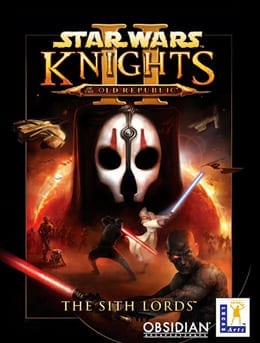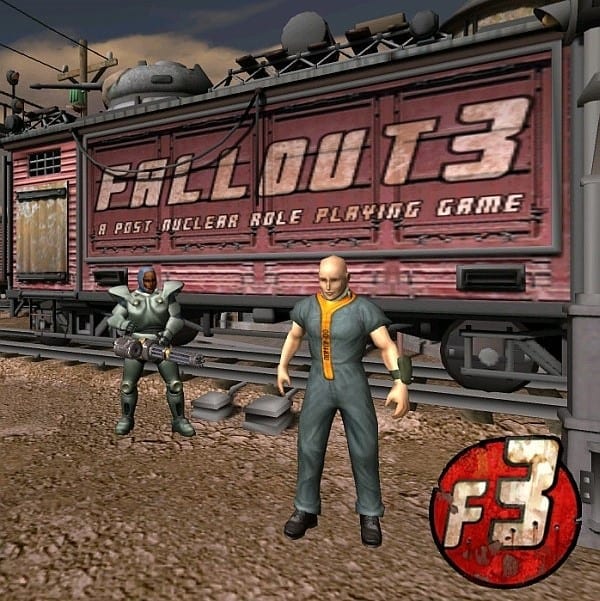Winterwind recently had the opportunity to interview Obsidian Entertainment’s Chris Avellone. This, then, is that interview.
Winterwind: First, you just got back from E3, what made you say “Wow”, and what didn’t live up to your expectations? Be honest.
Chris Avellone: My honesty is pretty boring (which is the excuse I use when caught lying), but here you go: I didn’t have any expectations for E3; most of the games being showcased I’d already seen bits of or I could check out on the net, and I was so burned out from doing the E3 KOTOR 2 demo that I couldn’t even focus half the time.(1) I went mostly to see friends who’ve gone to other companies and just catch up. And, of course, the booth babes.(2) And the massage room at the Gamespy/IGN booth.(3)
(Footnote 1) This is also the excuse used for why I was stumbling around “as if” I was drunk. Honestly.
(Footnote 2) I didn’t really want to see the booth babes until I got there, then I wanted to see a lot of them, since they’re all so tan and curvy in the right places.
(Footnote 3) Thanks to Kay, who gave me a massage ticket. Kay rocks.
WW: Is there a type of game you’re just itching to work on? Is it a certain type of RPG or maybe a different genre all together?
MCA: Yup. I’d love to work on a real world RPG, a high school-based RPG, and a few other crazier ideas that I’m not sure would work, but I’m dying to see if they could. Writing modern dialogue and dealing with real world themes is something I’d love to do. And then there’s times where I just want to do a game where the game world lends itself to allowing you to do anything, and you aren’t constrained by an existing game world’s design physics or genre parameters.
WW: While a few rpg’s, like Harvest Moon, get away without having swords and guns they seem to meet with limited success. Do you feel a non-violent RPG could be a “main stream” success in the age of Grand Theft Auto and Metal Gear?
MCA: Hey, if The Sims can do it, then there’s a chance.
WW: Many people notice a distinctive style in the areas and games you’ve designed. What are some of the influences that led to the development of your personal design style?
MCA: Caffeine, lots of comic books and novels, and writing a lot of superhero pen-and-paper supplements, actually – superhero games have such a strong focus on character, that I think it burned a lot of character development ideas into my brain. I don’t like doing happy endings for some reason, mostly because I don’t believe in them.
I also did a lot of GMing in junior high and high school (and again, when we were running our Fallout 3 pen and paper game), and I think the most important thing I learned from that is that your primary design goal is to provide an entertaining experience for your players, not for yourself.
WW: When asked their favorite game characters, many on these gaming message boards choose characters from Planescape: Torment. What are some of your favorite game characters that you didn’t have a hand in creating?
MCA: Floyd from Planetfall. Shodan from the System Shocks. Just about any of the voice-acted characters in Fallout 1 (Mark O’ Green has a great writing style). Fatima from Anachronox was one of the most brilliant characters ever, and I am insanely jealous I didn’t think of the idea of an interface with personality first – Tom Hall better watch himself if I ever cross paths with him in a dark alley. There’s probably a ton of others I’m forgetting. Oh, and this is totally stupid, but I liked Pondmuk from Icewind Dale 2, even though he was designed by Chris Parker.
WW: You worked on two games in a row at Interplay (Jefferson and Van Buren) that were shelved, both of which were eagerly anticipated by BIS fans. How did that effect your view of the industry and you personally?
MCA: Well, Jefferson was a splash of cold water followed by a slow, unsettling chill that it all could happen again. I think it was a combination of that and Feargus leaving that finally made me realize I couldn’t stay at Interplay any longer – a lot of work was invested in Jefferson, I think it was a good, solid hardcore PC RPG, and I had a lot of hopes for it.
To have it suddenly shelved by circumstances beyond your control is something you can expect to happen in the industry, but that had been happening a LOT at Interplay, and it’s frustrating to work hard on something and then watch it all get flushed – I mean, that’s almost a year and a half of your life, with nothing to show for it.
The artists were probably hit the worst – some of the art that was done for that game was amazing. I don’t really know how Sawyer stayed sane through all of it, but that man has a spine of steel. Anyway, to sum it up, projects getting cancelled just happens, but the reasons that projects were getting cancelled at Interplay never felt like good reasons.
WW: Anyone who asks around about the Van Buren (Fallout 3) storyline will quickly run into what I like to call “The Wall of MCA”, where people refuse to talk about it out of respect for your wishes. While bits and pieces of the story got out, most of it did not. Will we be seeing elements of the VB storyline in your upcoming games or are you saving it for the long shot of a Fallout 3 someday?
MCA: No, the Fallout 3 story was specific to Fallout; while there are elements that could be transferred, it wouldn’t feel right. I’d feel like I was cheating on Fallout or something. The story meant a lot to me, and there were certain characters that gained their strength because of their position and history in the Fallout universe.
WW: When you left Interplay for Obsidian, did you know at that time you would be working on KOTOR2?
MCA: Yes. I was a little intimidated, since I knew nothing about Star Wars beyond the movies and spent ten months going through all the Expanded Universe stuff just so I could understand who this Mara Jade person was, what the heck Skywalker was doing having children with her, and why Aurra Sing has an antenna coming out of her head.
I can’t say I achieved any sort of spiritual Star Wars enlightenment after reading all the novels and graphic novels, but it was just good to get the background of what other writers, game developers, and PNP game designers have already done in the universe so I wouldn’t be doing a story someone else had already done.
WW: For the first time that I can recall, it is very possible that the most widely anticipated upcoming RPG is coming out of the America. While success in RPG’s isn’t unheard of for North American companies, especially critical success, they don’t often get the “Final Fantasy” level of early hype that KOTOR2 is getting. Does that change how people approach their jobs? Do you guys ever stop and think: “Wow, this is as AAA as AAA gets”.
MCA: I think the guys here are really stoked by the coverage (seeing your concept art mounted on the ceiling of E3 and on the covers of multiple magazines can be a hell of a morale booster), but personally, I’m mostly too terrified to notice. BioWare did a great job on KOTOR 1 and that’s a tough act to follow. So basically, the fact it’s a triple A title means that we’re excited but also sweating blood, and there’s a lot of pressure, expectations, and it can be pretty daunting at times.
WW: Which is more unnerving, having to meeting Fallout fans expectations, or the wider audience of KOTOR expectations?
MCA: Fallout fan expectations. Star Wars fans are tame by comparison and use a lot less profanity. I’d hate to see the two groups of them get into a fight – the Fallout fans would shred the Star Wars fans in seconds. Still, the Fallout fans were always a good conscience.
WW: While KOTOR2 obviously isn’t a PC only RPG, do you think strong PC sales of the game could be the catalyst for that market to be reawakened? Do you think it possible for PC rpgs to rival their console cousins again one day?
MCA: I think they can – like you said, all it would take is just a PC RPG title to make a ton of cash, and suddenly publishers might be willing to give PC RPGs another chance. I’ll be honest – a PC-only RPG can be a pretty hard sell to many publishers out there, and there’s a lot of prejudice you have to get through.
WW: In a developer roundtable discussion it was said that you liked to build the stories in your games around certain themes. What are some of the themes that we can expect to explore in The Sith Lords?
MCA: Teaching as a theme, oddly enough (since I didn’t expect it until we started implementing characters and companions) – the mentor-apprentice relationship is one of the major themes the game revolves around. There are others, but that’s one of the more personal themes in the game.
WW: It’s not the biggest secret that Obsidian has another project waiting in the wings, but where do you see Obsidian going from here. You guys think you might be ready to gamble a bit on your own franchise?
MCA: Heck, yes. I think it’s every developer’s dream to do their own IP, and Obsidian is no different. We’ve got some great ideas in the works, and Ferg’s busy using Jedi mind tricks with publishers to help it see the light of day. We already got a lot of help from BioWare (getting KOTOR 2 right out the gate as a start-up surprised me), and I think our starting line of titles are going to be a good foundation to build Obsidian on… and should help when pitching new ideas to publishers.
-Check back with us soon for part two of the interview, where we’ll be focusing much more on Chris Avellone’s current game: Star Wars Knights of the Old Republic II: The Sith Lords
Note – This interview was originally published on the old Winterwind Productions site in May, 2004, prior to our switch to WordPress in 2020.
- The Winterwind Shorts - May 7, 2021
- Hot Karl is Coming! - April 28, 2021
- The Art of Mixing - February 25, 2021




